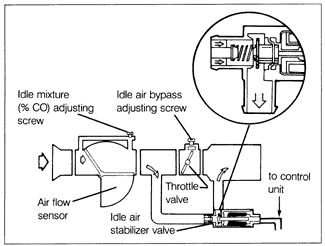7.3 Idle Speed
Engine idle speed is controlled not by a fine adjustment of the throttle valve, but by an idle air bypass. Through this bypass, a small amount of air is allowed past the closed throttle valve. By this method, idle speed is more reliable since it is independent of stretch in the accelerator cable or wear in the throttle valve mechanism. The idle air bypass is shown schematically in Fig. 7-9.
| Fig. 7-9. | Schematic view of air flow sensor and throttle valve showing idle air bypass and idle air stabilizer valve. |

|
The need for additional inlet air during cold running is handled much the same way, by allowing additional air to bypass the throttle valve. An idle air stabilizer valve, controlled by the Digifant control unit, maintains idle speed within a prescribed range.
Idle adjustment is somewhat complicated, due to the sensitive requirements of emission control and the combined effects of idle speed, ignition timing, and fuel mixture adjustment. Final adjustments to idle speed should only be made after ignition timing is adjusted to specification, and before idle mixture (% CO) is adjusted. See IGNITION and 7.6 Idle Mixture Specifications (% CO).
Making these checks and adjustments together and in the proper order is very important to both driveability and emissions control. If the equipment necessary to accurately perform this work is not available, we suggest turning the job over to an authorized Volkswagen dealer or other qualified repair shop. In a properly equipped shop, these checks and adjustments can be made quickly, accurately, and at reasonable cost.
When adjusting idle, the following conditions are required:
| 1. | The engine must be at normal operating temperature (oil temperature at least 176°F (80°C)). The radiator fan should have cycled on and off at least once. |
| 2. | All electrical accessories should be off (including the radiator cooling fan-make adjustment only when the fan is not running). |
| 3. | The idle stabilizer valve must be operating correctly. (It should vibrate and hum slightly when the ignition is on). |
| 4. | The throttle valve idle switch must be operating correctly. (Idle speed changes noticeably when switch harness connector is disconnected and reconnected). |
| 5. | The exhaust system must be free of leaks. |
| 6. | There must be no engine vacuum leaks. |
| 7. | The oxygen sensor must be operating correctly. |
| 8. | When the engine is started, briefly raise the engine speed to over 2100 rpm. Repeat this step four times to cancel the electronic control unit's built-in hot-start fast idle function. |
Connect a tachometer according to the instrument manufacturer's instructions in order to accurately measure engine rpm. The ignition signal lead from the tachometer should be connected to terminal 1 of the coil.
